FinShaggy's Religious Marijuana Grow Journal
- Thread starter Finshaggy
- Start date
Finshaggy
Well-Known Member
And that Durban strain I got, Early Durban. If it is Female I think I might flower it. It is Durban Poison X Skunk # 1, so I think that it is probably better than most people assume. "Early Durban" is more of a name targeted at growers than smokers, and even growers tend to pick names based on their expected smoke. So "Early Durban" is probably often overlooked, but being Durban Poison X Skunk # 1, it is probably really good.
Finshaggy
Well-Known Member
And if the African Buzz is male and ACE Malawi is female or vice versa I'll keep the female as a motherplant for clones, and I'll flower it in the 2nd 2 months and maybe even do a full Malawi flower with 3 Malawi plants and breed them with other strains and the mixed strains. And just do a 4 month flower.
Finshaggy
Well-Known Member
This part is going to be about Preflower, which is how you identify male and female plants. Part 4 will introduce you to the concept and Part 5 will show you male and female preflower on my plants.
Gender
Here is the "Preflower" this is how you determine the gender of a Marijuana plant.

I currently can only actually tell the gender of the clones. With a clone you are guaranteed to a get a plant that is the same gender as the plant that the cutting was taken from. This means that if you take a male cutting you will get a male clone, if you take a female cutting you will get a female clone. A female clone could end up going "Hermie", which means it turns into a Hermaphrodite and has male and female genitalia and pollenates itself. You won't be able to tell it is Hermie until during the flower cycle when little Banana looking pollen sacks grow.
You can force a plant to go Hermie by putting Silver materials in its soil, or by rubbing a product called "Colloidal Silver" all over the plant's leaves. This will force the plant to go Hermie. A Hermie plant will have seeds that don't have the male Chromosome.
This is the Girl Scout Cookies Clone, and I knew it would be female because I got it as a Clone.
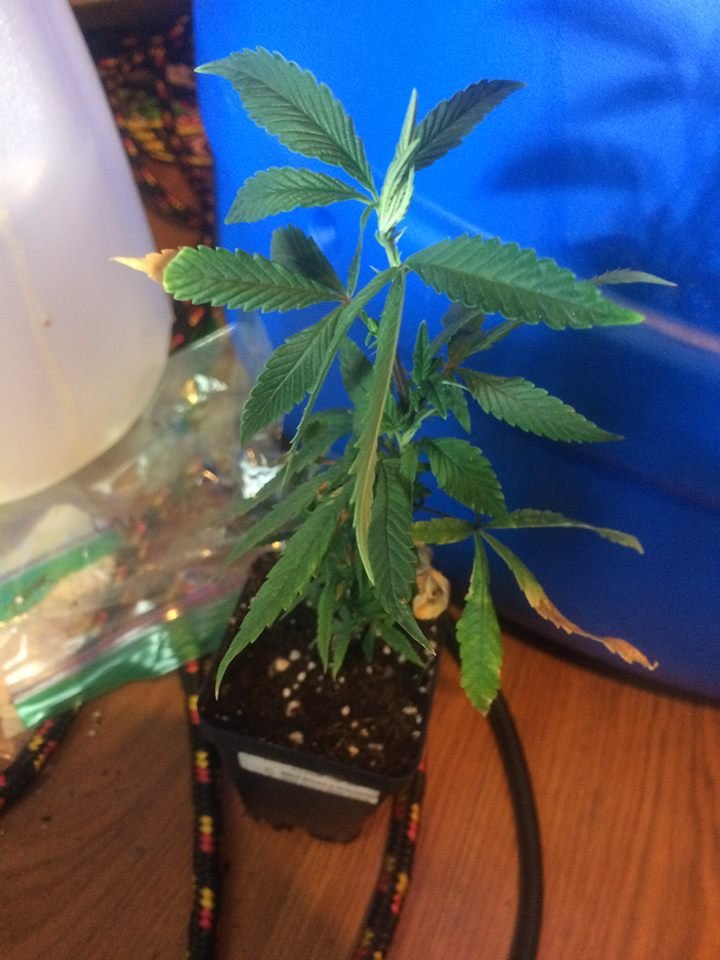
As you can see, not only does it have the little prong/hair/leaf looking things growing, it has something like a small nug of Marijuana growing out above the prong/hair/leaf thing. This shows it is female. I do not have any examples of males yet, but will explain that next and show males in the next part.
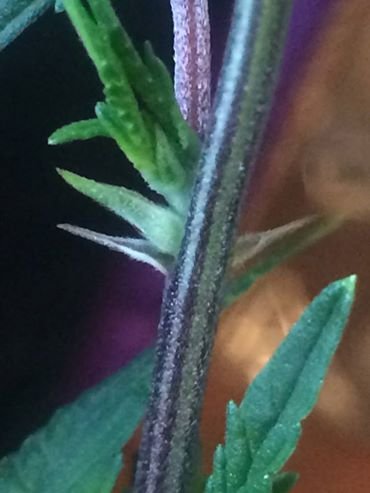
This is the Early Durban, I still do not know if it is male or female.
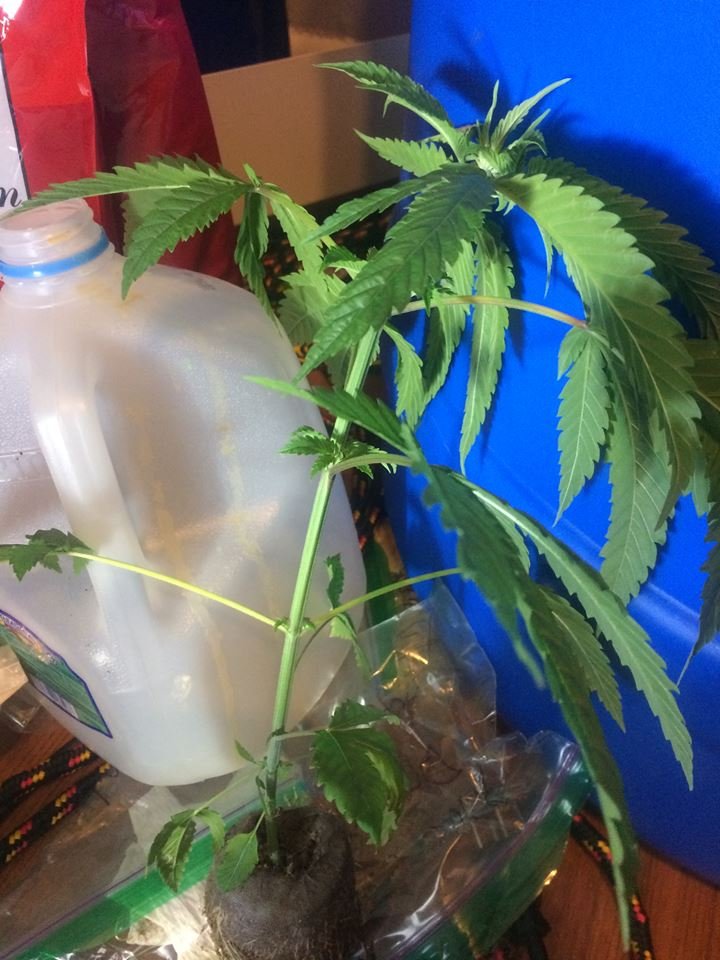
Notice the little prong/hair/leaf things, there are 2 of them. Right behind those is where the male or female parts will grow and then I will be able to tell if this plant is a male or female. Pretty much all the plants that I started from seed have this right now except for the Banana Crack and White Strawberry Skunk.
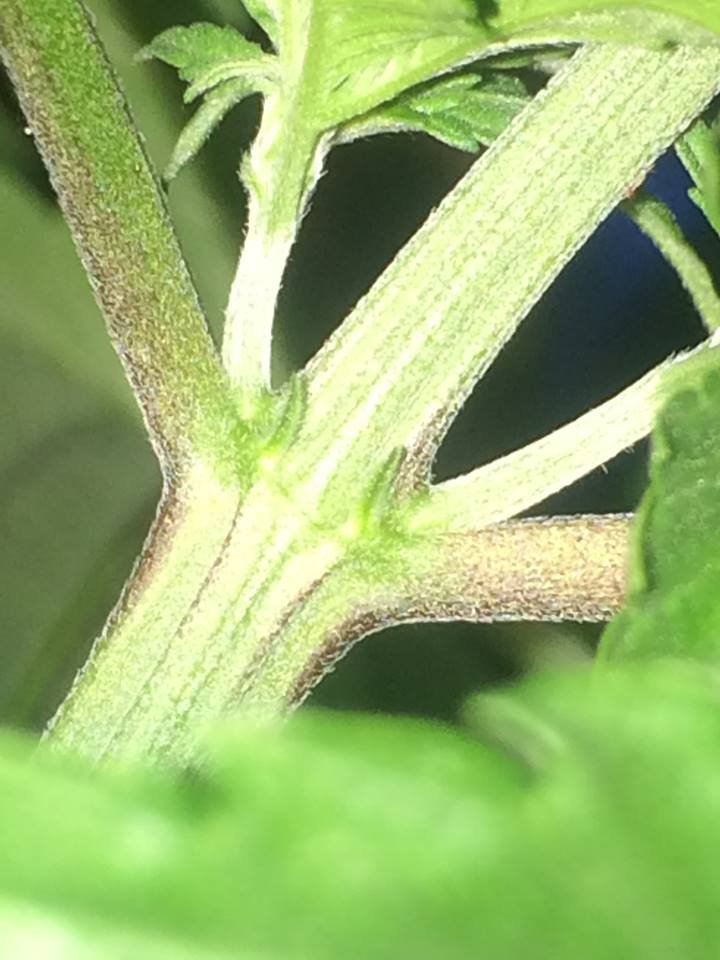
So those little prongs/hairs/leaves are the preflower spot and are where you will look to determine the gender of your plants. Most people, at the time they find out, will kill all the males to prevent them from putting pollen and therefore seeds in their females. But I am breeding, so I will need both males and females.
Breeding
Here is the plan for the breeding program.
African strains being "A"
Aromatic strain being "B"
Commercial strain being "C"
We can end up with these combos:
A X B X C
A X C X A
A X B X A
A X B X C X A
A X B X C X B
Here is how I am selecting genetics, it is also how I will do it with the marker information, but this is how I am doing it for now.
First, I am using seed finder to find lineages, and many of the plants I have are landrace or basically landrace, so they don't have much of a genetic line if a genetic line at all. But the ones that do, what I am doing is trying to match up their backgrounds.
This is called Recombination. For example, if I take Danky Kong, which is 1/4 White Russian, and breed that with White Rhino, then the White Widow genes are "Recombining" after being altered slightly by other genes. Kind of like if Darwin's Finches mated, and created a Recombined breed of finches.
Second, I am looking for similar genetics that come from different lines. An example would be the frostiness of the White Widow strains, White Russian, White Rhino, etc, combined with the Frostiness of the Tahoe OG. These are 2 different lines, but combined would have extra frostiness. So Danky Kong mixed with Tahoe OG would probably be super frosty. And because Danky Kong has Diesel genetics, and Tahoe OG smells like Kerosene, the genetics that create their smells would probably combine well also.
I am basically in the end going to be doing like Bomb Seeds did, but instead of making a strain that brings out big yields and dense nugs, I want to bring out THCV, and smells and whatever else is hidden in the African genetics.
Basically, Bomb Seeds made their Bomb #1 Phenotype, and they combine it with Cheese to make a bigger and higher yielding Cheese plant, or Sour Diesel for a bigger and higher yielding Sour Diesel plant.
But what I am doing is making sure that everything has African Genetics, and Heavy Aromatic Genetics, then Kush, Haze, White Widow, etc, genetics.
Those will stand as strains of their own once they are stabilized, and maybe after mixing in another African strain or Aromatic strain with some of them. But then I will start mixing those strains together. Like (A X B XC) X (D X E X F) until I find a really frosty, strong, aromatic, unique breeding plant. Then I will lock in the genetics and maybe pick a phenotype if one is best. Then I will create a line by crossing that strain with regular dispensary strains, and pure landrace strains.
Gender
Here is the "Preflower" this is how you determine the gender of a Marijuana plant.

I currently can only actually tell the gender of the clones. With a clone you are guaranteed to a get a plant that is the same gender as the plant that the cutting was taken from. This means that if you take a male cutting you will get a male clone, if you take a female cutting you will get a female clone. A female clone could end up going "Hermie", which means it turns into a Hermaphrodite and has male and female genitalia and pollenates itself. You won't be able to tell it is Hermie until during the flower cycle when little Banana looking pollen sacks grow.
You can force a plant to go Hermie by putting Silver materials in its soil, or by rubbing a product called "Colloidal Silver" all over the plant's leaves. This will force the plant to go Hermie. A Hermie plant will have seeds that don't have the male Chromosome.
This is the Girl Scout Cookies Clone, and I knew it would be female because I got it as a Clone.

As you can see, not only does it have the little prong/hair/leaf looking things growing, it has something like a small nug of Marijuana growing out above the prong/hair/leaf thing. This shows it is female. I do not have any examples of males yet, but will explain that next and show males in the next part.

This is the Early Durban, I still do not know if it is male or female.

Notice the little prong/hair/leaf things, there are 2 of them. Right behind those is where the male or female parts will grow and then I will be able to tell if this plant is a male or female. Pretty much all the plants that I started from seed have this right now except for the Banana Crack and White Strawberry Skunk.

So those little prongs/hairs/leaves are the preflower spot and are where you will look to determine the gender of your plants. Most people, at the time they find out, will kill all the males to prevent them from putting pollen and therefore seeds in their females. But I am breeding, so I will need both males and females.
Breeding
Here is the plan for the breeding program.
African strains being "A"
Aromatic strain being "B"
Commercial strain being "C"
We can end up with these combos:
A X B X C
A X C X A
A X B X A
A X B X C X A
A X B X C X B
Here is how I am selecting genetics, it is also how I will do it with the marker information, but this is how I am doing it for now.
First, I am using seed finder to find lineages, and many of the plants I have are landrace or basically landrace, so they don't have much of a genetic line if a genetic line at all. But the ones that do, what I am doing is trying to match up their backgrounds.
This is called Recombination. For example, if I take Danky Kong, which is 1/4 White Russian, and breed that with White Rhino, then the White Widow genes are "Recombining" after being altered slightly by other genes. Kind of like if Darwin's Finches mated, and created a Recombined breed of finches.
Second, I am looking for similar genetics that come from different lines. An example would be the frostiness of the White Widow strains, White Russian, White Rhino, etc, combined with the Frostiness of the Tahoe OG. These are 2 different lines, but combined would have extra frostiness. So Danky Kong mixed with Tahoe OG would probably be super frosty. And because Danky Kong has Diesel genetics, and Tahoe OG smells like Kerosene, the genetics that create their smells would probably combine well also.
I am basically in the end going to be doing like Bomb Seeds did, but instead of making a strain that brings out big yields and dense nugs, I want to bring out THCV, and smells and whatever else is hidden in the African genetics.
Basically, Bomb Seeds made their Bomb #1 Phenotype, and they combine it with Cheese to make a bigger and higher yielding Cheese plant, or Sour Diesel for a bigger and higher yielding Sour Diesel plant.
But what I am doing is making sure that everything has African Genetics, and Heavy Aromatic Genetics, then Kush, Haze, White Widow, etc, genetics.
Those will stand as strains of their own once they are stabilized, and maybe after mixing in another African strain or Aromatic strain with some of them. But then I will start mixing those strains together. Like (A X B XC) X (D X E X F) until I find a really frosty, strong, aromatic, unique breeding plant. Then I will lock in the genetics and maybe pick a phenotype if one is best. Then I will create a line by crossing that strain with regular dispensary strains, and pure landrace strains.
whitebb2727
Well-Known Member
Yea and those assholes make sure to leave a bunch of seeds to ruin the landraces anywhere they visit.I wonder how much of that is BS to be honest, I once heard of a UK seedbank when they were looking to name a new interesting strain they asked one employee what his favourite fruit was--and he said Strawberries--they then asked another guy what his favourite TYPE of weed was- and he answered '' I like Hazes '' so they named the new strain Strawberry Haze. If you specifically want to home in on African strains theres a good YouTube video called strain Hunters Swaziland which is a bunch of guys from the Greenhouse coofeeshop in Amsterdam going to Swaziland and looking for original African genetics to take home and develop--you might like it, check it out
Greenhouse seeds is also known to be junk.
whitebb2727
Well-Known Member
You do realize the people that breed grow out hundreds if not thousands of plants.This part is going to be about Preflower, which is how you identify male and female plants. Part 4 will introduce you to the concept and Part 5 will show you male and female preflower on my plants.
Gender
Here is the "Preflower" this is how you determine the gender of a Marijuana plant.

I currently can only actually tell the gender of the clones. With a clone you are guaranteed to a get a plant that is the same gender as the plant that the cutting was taken from. This means that if you take a male cutting you will get a male clone, if you take a female cutting you will get a female clone. A female clone could end up going "Hermie", which means it turns into a Hermaphrodite and has male and female genitalia and pollenates itself. You won't be able to tell it is Hermie until during the flower cycle when little Banana looking pollen sacks grow.
You can force a plant to go Hermie by putting Silver materials in its soil, or by rubbing a product called "Colloidal Silver" all over the plant's leaves. This will force the plant to go Hermie. A Hermie plant will have seeds that don't have the male Chromosome.
This is the Girl Scout Cookies Clone, and I knew it would be female because I got it as a Clone.

As you can see, not only does it have the little prong/hair/leaf looking things growing, it has something like a small nug of Marijuana growing out above the prong/hair/leaf thing. This shows it is female. I do not have any examples of males yet, but will explain that next and show males in the next part.

This is the Early Durban, I still do not know if it is male or female.

Notice the little prong/hair/leaf things, there are 2 of them. Right behind those is where the male or female parts will grow and then I will be able to tell if this plant is a male or female. Pretty much all the plants that I started from seed have this right now except for the Banana Crack and White Strawberry Skunk.

So those little prongs/hairs/leaves are the preflower spot and are where you will look to determine the gender of your plants. Most people, at the time they find out, will kill all the males to prevent them from putting pollen and therefore seeds in their females. But I am breeding, so I will need both males and females.
Breeding
Here is the plan for the breeding program.
African strains being "A"
Aromatic strain being "B"
Commercial strain being "C"
We can end up with these combos:
A X B X C
A X C X A
A X B X A
A X B X C X A
A X B X C X B
Here is how I am selecting genetics, it is also how I will do it with the marker information, but this is how I am doing it for now.
First, I am using seed finder to find lineages, and many of the plants I have are landrace or basically landrace, so they don't have much of a genetic line if a genetic line at all. But the ones that do, what I am doing is trying to match up their backgrounds.
This is called Recombination. For example, if I take Danky Kong, which is 1/4 White Russian, and breed that with White Rhino, then the White Widow genes are "Recombining" after being altered slightly by other genes. Kind of like if Darwin's Finches mated, and created a Recombined breed of finches.
Second, I am looking for similar genetics that come from different lines. An example would be the frostiness of the White Widow strains, White Russian, White Rhino, etc, combined with the Frostiness of the Tahoe OG. These are 2 different lines, but combined would have extra frostiness. So Danky Kong mixed with Tahoe OG would probably be super frosty. And because Danky Kong has Diesel genetics, and Tahoe OG smells like Kerosene, the genetics that create their smells would probably combine well also.
I am basically in the end going to be doing like Bomb Seeds did, but instead of making a strain that brings out big yields and dense nugs, I want to bring out THCV, and smells and whatever else is hidden in the African genetics.
Basically, Bomb Seeds made their Bomb #1 Phenotype, and they combine it with Cheese to make a bigger and higher yielding Cheese plant, or Sour Diesel for a bigger and higher yielding Sour Diesel plant.
But what I am doing is making sure that everything has African Genetics, and Heavy Aromatic Genetics, then Kush, Haze, White Widow, etc, genetics.
Those will stand as strains of their own once they are stabilized, and maybe after mixing in another African strain or Aromatic strain with some of them. But then I will start mixing those strains together. Like (A X B XC) X (D X E X F) until I find a really frosty, strong, aromatic, unique breeding plant. Then I will lock in the genetics and maybe pick a phenotype if one is best. Then I will create a line by crossing that strain with regular dispensary strains, and pure landrace strains.
Chucking pollen on a few plants won't stabilize a strain.
How do you plan to grow enough plants to select the best representation of each strain?
Last edited:
too larry
Well-Known Member
I have never grown with lights, so I have no experience having to choose females to flower. What % of your females do you choose not to flower? What goes into that decision? Structure? Smell? Over all health?And that Durban strain I got, Early Durban. If it is Female I think I might flower it. . . . . . .
As an outdoor grower, I flower everything. Then I decide what to cross by how they do. Limiting yourself to one female plant of a strain would be impossible for me. Last year I had close to 100 out at one point in the season. Only about 10 of them were worth chucking pollen at. {I'm no breeder, but I do try to use the best of what I have when making seeds}
Unless you are getting a special cut from a trusted source, seeds offer so many more variables than clones. When looking for that golden bean, variety is what you want.
Finshaggy
Well-Known Member
I believe in Epigenetics and evolution.I have never grown with lights, so I have no experience having to choose females to flower. What % of your females do you choose not to flower? What goes into that decision? Structure? Smell? Over all health?
As an outdoor grower, I flower everything. Then I decide what to cross by how they do. Limiting yourself to one female plant of a strain would be impossible for me. Last year I had close to 100 out at one point in the season. Only about 10 of them were worth chucking pollen at. {I'm no breeder, but I do try to use the best of what I have when making seeds}
Unless you are getting a special cut from a trusted source, seeds offer so many more variables than clones. When looking for that golden bean, variety is what you want.
This is really the main argument between me and the trolls who actually think they are making a point when it comes t my grows.
I don't personally think that perfectly selected Genetics work alone, or are even specifically necessary in order to create a good strain. Sure, if you take Tahoe OG and cross it with Cindy 99, those are so selected that you will get a predictable result. But I believe that you can get just as good a result from African Landrace Genetics (or even Mexican brick weed Genetics), if you cross it with good Genetics (not even good selected Genetics) or even if you just treat the plants in a harsh way. You can create better strains, but then there is the recombination factor and the matching factor.
I am making selections, I just believe in other mothods of bringing out the good genes. Epigenetics, recombination and matching.
Plus, just as an example. The African Buzz is actually a selected Malawi Gold variety, and people say it's pretty much the same plant every time.
Finshaggy
Well-Known Member
Basically, I'm more interested in the genetic backgrounds. For example, I wanted Erdbeer genes, I could have gotten them fri Strawberry Diesel, Strawberry Stardawg, etc, but I got it from White Strawberry Skunk. I wanted Banana OG genes, I could have gotten it from Banana Sativa, Banana Bread, etc, but I decided to get it from Banana Crack. I just want the genes that I want in their background then I'll find a way to bring out the genes I want.
too larry
Well-Known Member
Thanks for the explanation. My first couple of years back growing I did plenty of stressing my plants. Not because I wanted to, it was just too dry and I could't get enough water to the number I had. I jokingly said I was trying to breed a strain that thrived on neglect. And since the ones that died from the drought couldn't reproduce, I guess I was.
Finshaggy
Well-Known Member
I was originally using bagseed from good mids which we called "popcorn" in Texas, I think it was called that because if the seeds and nugs, but everyone just calls it popcorn and always had there, so I don't know why.Thanks for the explanation. My first couple of years back growing I did plenty of stressing my plants. Not because I wanted to, it was just too dry and I could't get enough water to the number I had. I jokingly said I was trying to breed a strain that thrived on neglect. And since the ones that died from the drought couldn't reproduce, I guess I was.
But my goal was to breed a strain that would grow good weed in the ditches of Texas, and you could just take it, kill the males when you grew the seeds out of the ditch weed, and grow good buds.
I still plan on spreading seeds and clones around and I'll try to get my stuff into outdoor Genetics eventually.
too larry
Well-Known Member
It is interesting how terms mean different things in different places. Most growers call the small buds on the lower limbs popcorn. They are removed because the time spent trimming them are not worth the weight. Also called larf, and when not cut off before harvest is made into hash, edibles or extracts. Larf is what you make it.
I've grown a little bag seed now and again. But most of the time the seeds are the result of hermie plants, and you have to watch them like a hawk. If you already gave good genetics nearby, it is not worth the risk.
As far as growing brick weed in ditches, that is a good way to screw lots of hard working growers. You are responsible for everything you do, including setting out more plants than you can control. Primum non nocere.
I've grown a little bag seed now and again. But most of the time the seeds are the result of hermie plants, and you have to watch them like a hawk. If you already gave good genetics nearby, it is not worth the risk.
As far as growing brick weed in ditches, that is a good way to screw lots of hard working growers. You are responsible for everything you do, including setting out more plants than you can control. Primum non nocere.
Finshaggy
Well-Known Member
Ditch weed and wild plants already exist, not in the US in any great number. At least not in the Mid-West or the south as far as I know. Most of it is grown by people. But ditch weed and wild plants do exist. To boost the quality of Genetics in my region would cause more people to spread it and grow it, and would cause there to be more males and more pollen in the air. But that's just the nature of outdoor strains and the creation of Landrace Genetics.It is interesting how terms mean different things in different places. Most growers call the small buds on the lower limbs popcorn. They are removed because the time spent trimming them are not worth the weight. Also called larf, and when not cut off before harvest is made into hash, edibles or extracts. Larf is what you make it.
I've grown a little bag seed now and again. But most of the time the seeds are the result of hermie plants, and you have to watch them like a hawk. If you already gave good genetics nearby, it is not worth the risk.
As far as growing brick weed in ditches, that is a good way to screw lots of hard working growers. You are responsible for everything you do, including setting out more plants than you can control. Primum non nocere.
Finshaggy
Well-Known Member
All the plants that were germinated at the beginning of this thread are getting to a pretty good size now. I'm ready to find which ones are which gender, and they are about to start showing.
And about a week ago we found a lady bug in the house, so we put it in the tent, and it's still there. That's the only bug in the tent and it will eat any others that try to come in.
And about a week ago we found a lady bug in the house, so we put it in the tent, and it's still there. That's the only bug in the tent and it will eat any others that try to come in.
Finshaggy
Well-Known Member
Aphids. Aphids are actually considered a pest on most farms, but you can use them as food for other bugs.

http://berkshirebiological.com/product/aphids-50/
To farm Aphids you just need:
An area that can be kept at 65-80 degrees Fahrenheit
A fine screen or glass top (they can escape)
Fava bean seeds and/or Alfalfa seeds (You will grow these plants as their food)
A grow light, soil, small grow containers (Dixie cups)
And of course Aphids
Then you just grow the plants, when they sprout place them in the Aphid cage, and let the Aphids eat the plants. And prove them with a little water, maybe a bottle cap or sponge.
Ants. Many people see Ants as a pest, but again, you can use them as food for other creatures.

http://www.antskingdom.com/lasius-flavus-queen-and-5-workers.html
Ants eat anything with Sugar in it, or Sugar, as well as dead insects for protein. A few species of Ants are even known for Farming Aphids themselves (called Dairying Ants), such as Lasius Niger & Lasius Flavus. They will protect Aphids and collect Honeydew from them.
To farm Ants you just need:
A jar or large container (depending how large you want the colony to be), and a smaller jar to put in the jar if you want the ants to make tunnels that are visible and not too deep in the container. Put small holes in it (They can escape)
2 Parts Dirt 1 Part Sand (a little wet but not flooded, wet Cotton balls can be used later to provide moisture), don't pack the dirt. Leave 1 inch of space (at least) at the top so they don't get out when you open it.
A Queen Ant
Cover the container when not watching (or get a non-clear container) so they will be more active, as they tunnel at night or underground.
Don't let them overheat from the sun in a glass container.
Crickets. Crickets are used as food for various animals, and are beginning to be used as food for humans.
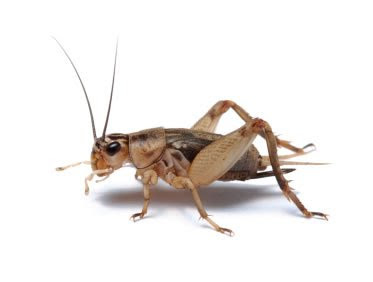
http://www.premiumcrickets.com/products/1000-crickets__1000.aspx
Crickets eat Lettuce and Oatmeal, breed in moist sand and need a cover that won't allow their tiny hatchlings to escape.
Dung Beetles (Scarabs). This is actually becoming more common, but on a farm you can actually employ dung beetles to clean up after your Animals.
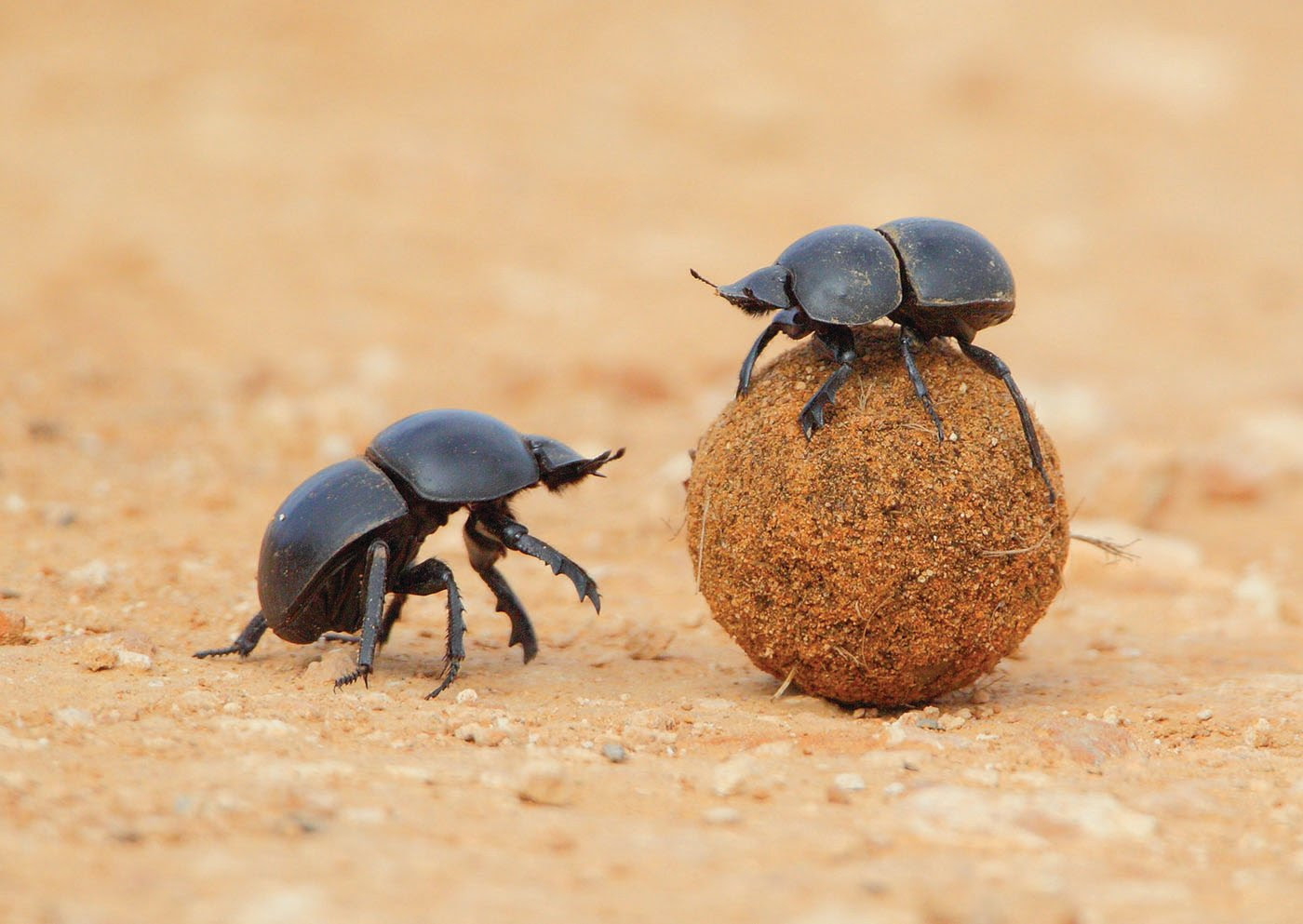
http://www.dungbeetles.biz/
http://shop.bugsincyberspace.com/Glorious-Scarab-bic952.htm
Bumble Bees & other Bees can be used to Pollinate your plants, as well as make Honey. If you Farm Aphids, the Bees may collect Honeydew and make Forrest Honey. You can also get Bee Phermones that will promote any wandering bees to come create a hive.

https://www.planetnatural.com/product/bumble-bees-natupol/
http://www.swarmcommander.com/
Hoverflies. These are like Bees, but more precise/less clumsy. You can't buy them as far as I know, but you can grow plants that will attract them. Plants that attract them include: Queen Anne's Lace, Copper Canyon Daisies, Alyssum, Calendula, Cosmos, Cornflowers, Agrostemma, Meadowfoam, Angelica, Buddleja, Iberis, Yarrow, Goldenrod, Asteraceae, Apiaceaea, Rosaceae, Rhamnaceae, Boraginaceae, Salicaceae and they like to spend winter in plant litter, like leaf piles.

http://www.americanmeadows.com/wildflower-seeds/wildflower-species/queen-annes-lace-seeds

http://berkshirebiological.com/product/aphids-50/
To farm Aphids you just need:
An area that can be kept at 65-80 degrees Fahrenheit
A fine screen or glass top (they can escape)
Fava bean seeds and/or Alfalfa seeds (You will grow these plants as their food)
A grow light, soil, small grow containers (Dixie cups)
And of course Aphids
Then you just grow the plants, when they sprout place them in the Aphid cage, and let the Aphids eat the plants. And prove them with a little water, maybe a bottle cap or sponge.
Ants. Many people see Ants as a pest, but again, you can use them as food for other creatures.

http://www.antskingdom.com/lasius-flavus-queen-and-5-workers.html
Ants eat anything with Sugar in it, or Sugar, as well as dead insects for protein. A few species of Ants are even known for Farming Aphids themselves (called Dairying Ants), such as Lasius Niger & Lasius Flavus. They will protect Aphids and collect Honeydew from them.
To farm Ants you just need:
A jar or large container (depending how large you want the colony to be), and a smaller jar to put in the jar if you want the ants to make tunnels that are visible and not too deep in the container. Put small holes in it (They can escape)
2 Parts Dirt 1 Part Sand (a little wet but not flooded, wet Cotton balls can be used later to provide moisture), don't pack the dirt. Leave 1 inch of space (at least) at the top so they don't get out when you open it.
A Queen Ant
Cover the container when not watching (or get a non-clear container) so they will be more active, as they tunnel at night or underground.
Don't let them overheat from the sun in a glass container.
Crickets. Crickets are used as food for various animals, and are beginning to be used as food for humans.

http://www.premiumcrickets.com/products/1000-crickets__1000.aspx
Crickets eat Lettuce and Oatmeal, breed in moist sand and need a cover that won't allow their tiny hatchlings to escape.
Dung Beetles (Scarabs). This is actually becoming more common, but on a farm you can actually employ dung beetles to clean up after your Animals.

http://www.dungbeetles.biz/
http://shop.bugsincyberspace.com/Glorious-Scarab-bic952.htm
Bumble Bees & other Bees can be used to Pollinate your plants, as well as make Honey. If you Farm Aphids, the Bees may collect Honeydew and make Forrest Honey. You can also get Bee Phermones that will promote any wandering bees to come create a hive.

https://www.planetnatural.com/product/bumble-bees-natupol/
http://www.swarmcommander.com/
Hoverflies. These are like Bees, but more precise/less clumsy. You can't buy them as far as I know, but you can grow plants that will attract them. Plants that attract them include: Queen Anne's Lace, Copper Canyon Daisies, Alyssum, Calendula, Cosmos, Cornflowers, Agrostemma, Meadowfoam, Angelica, Buddleja, Iberis, Yarrow, Goldenrod, Asteraceae, Apiaceaea, Rosaceae, Rhamnaceae, Boraginaceae, Salicaceae and they like to spend winter in plant litter, like leaf piles.

http://www.americanmeadows.com/wildflower-seeds/wildflower-species/queen-annes-lace-seeds
Finshaggy
Well-Known Member
Encarsia Formosa. This is the most widely used Organic insecticide in the world. It is a bug that eats Whiteflies.
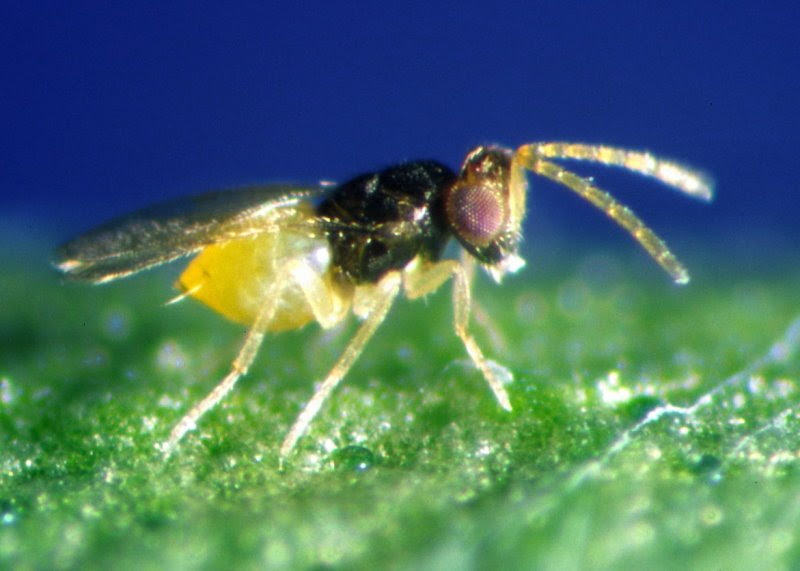
https://greenmethods.com/encarsia/
Damselflies and Dragonflies. Both of these eat Mosquitoes, so are good to have around.

http://www.carolina.com/aquatic-insects/damselfly-nymphs-living-pk-12/143520.pr

http://www.carolina.com/aquatic-insects/dragonfly-nymphs-living-pk-12/143526.pr
Ladybugs eat Aphids, so they are good to have around, and you can farm them with Aphids as food. A Gallon of Ladybugs is over $70.
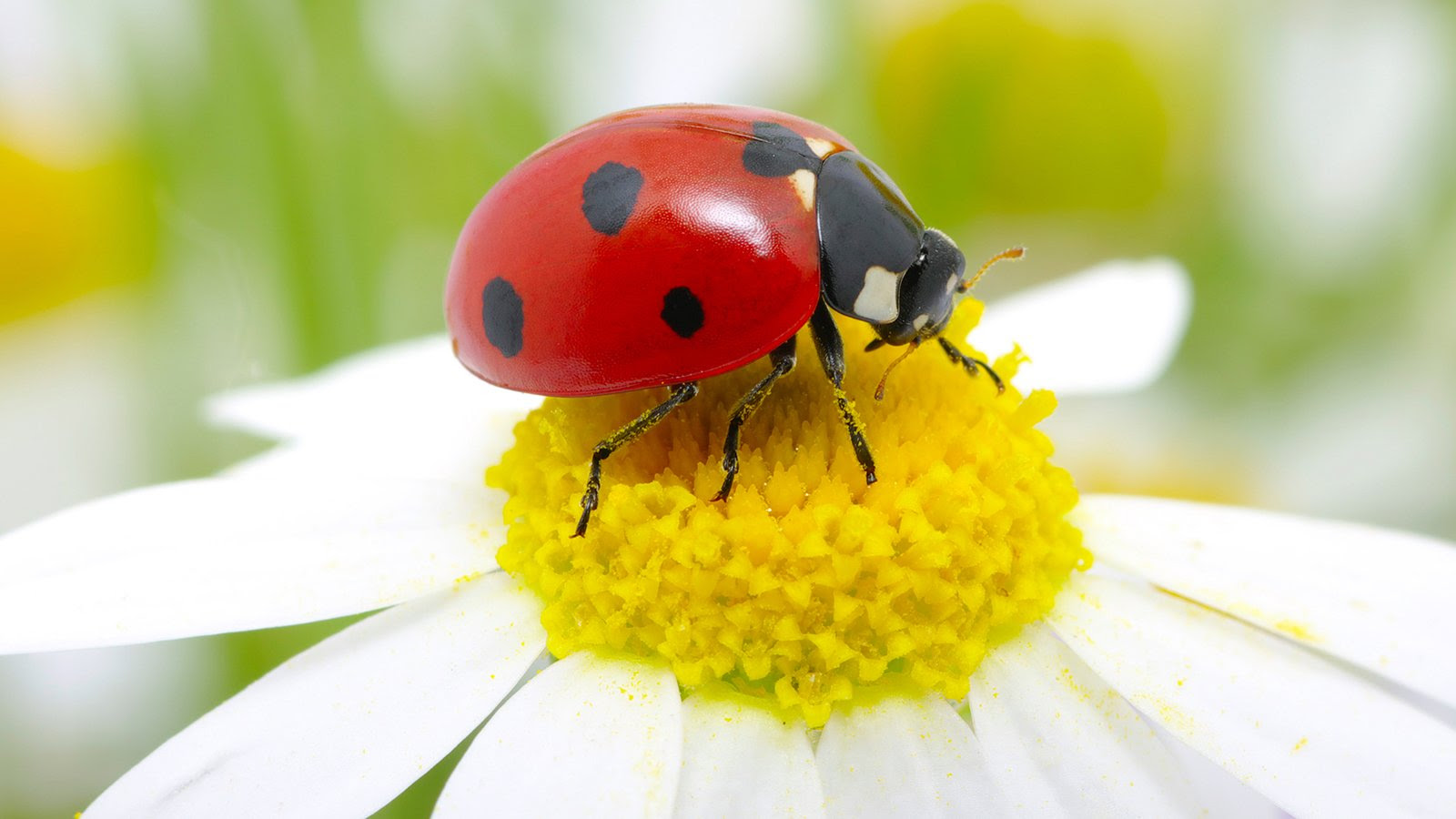
https://www.planetnatural.com/product/live-ladybugs/
Orius Insidiousus. Eats mites.
https://upload.wikimedia.org/wikipedia/commons/5/5b/Orius_insidiosus_from_USDA_2_(cropped).jpg
https://greenmethods.com/orius/
Assassin Bugs. These eat Cockroaches and Bedbugs.

http://www.arbico-organics.com/product/assassin-bug-zelus-renardii/beneficial-insects-predators-parasites
Soldier Bug. These eat over 100 kinds of pests.
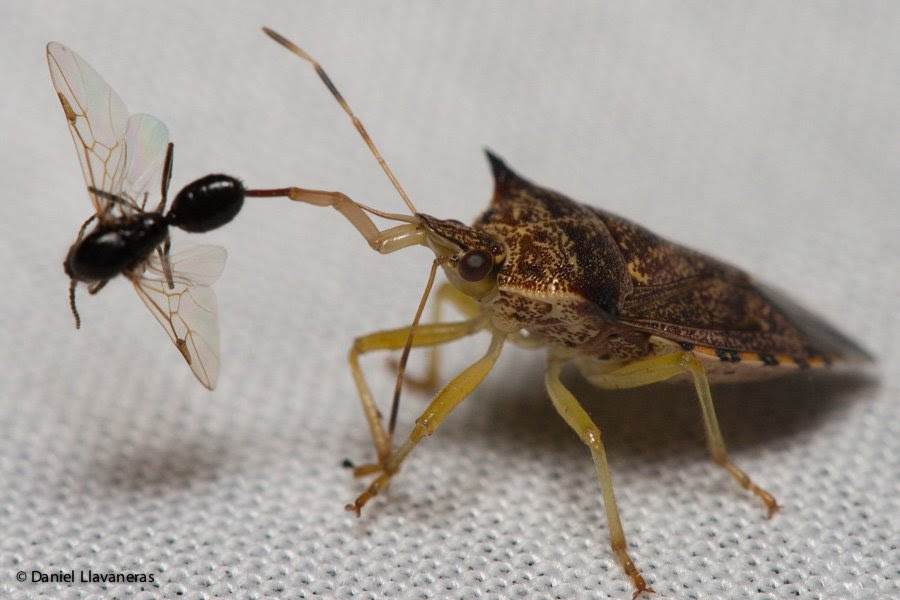
http://www.arbico-organics.com/product/spined-soldier-bug-podisus-maculaventris/beneficial-insects-predators-parasites
Praying Mantis. They eat any other kind of bug, and will even eat each other.
http://yourshot.nationalgeographic.com/u/ss/fQYSUbVfts-T7pS2VP2wnKyN8wxywmXtY0-Fwsgxo7q7my7f2GZLNS4giTv8-jCBYWzPZjkOOIwdkCXxgrEb/
https://www.planetnatural.com/product/praying-mantis-egg-cases/
Mealybug Destroyers. These eat any kind of Mealybug or Scale Bug, like the kind that come in neighborhoods that have too many Crape Myrtle trees.

https://greenmethods.com/product/cryptolaemus-montrouzieri-adult-beetles/
Tiger Beetles. These eat Ants, Flies, Grasshoppers, Spiders, etc, and are used as food by people in Mexico.
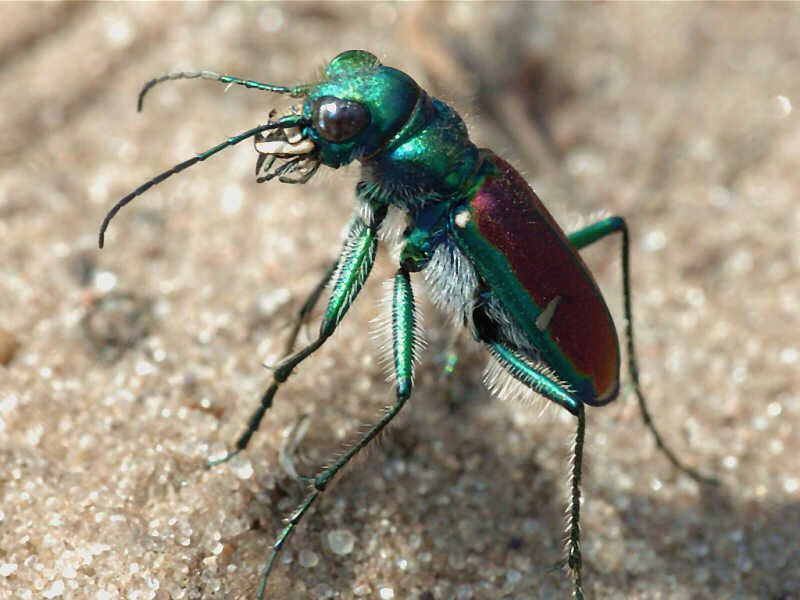
Green Lacewings. These eat mites and aphids.
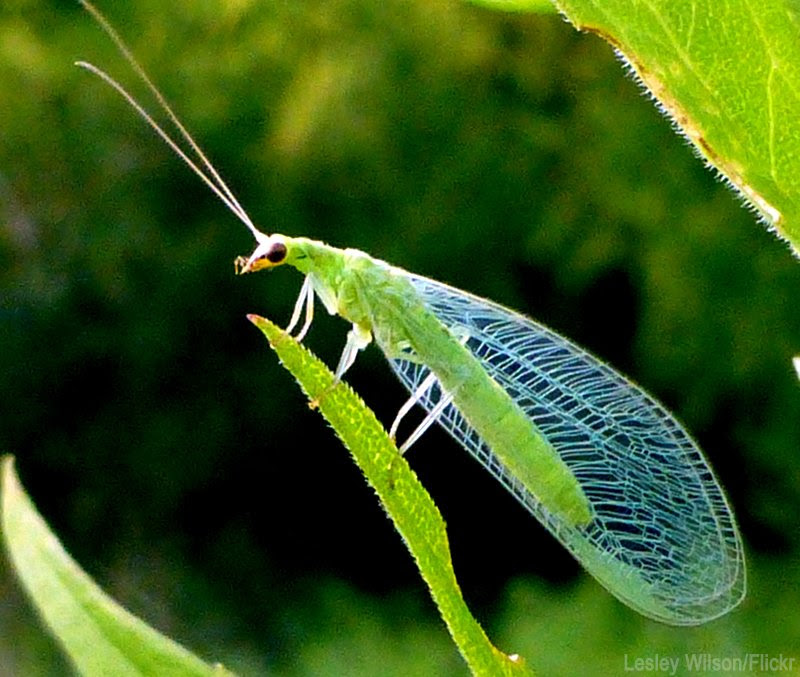
https://greenmethods.com/chrysoperla/
Ichneumon wasp. These wasps lay a parasitic eggs that eat the eggs of pest bugs like aphids. They do not sting, their stinger is used to lay eggs more precisely.

Trichogramma wasp. Another parasitic egg laying wasp.

https://www.planetnatural.com/product/trichogramma-wasps/
A. Colemani. Parasitic eggs against aphids.
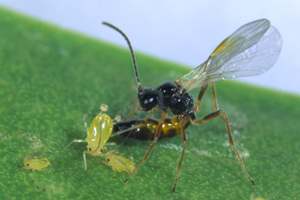
https://greenmethods.com/product/aphidius-colemani-parasitoid-mummies/
Phytoseiulus Persimilis. Eats spider mites but won't bite humans or pets. Good for indoor plant growers as spider mites are an indoor problem usually.
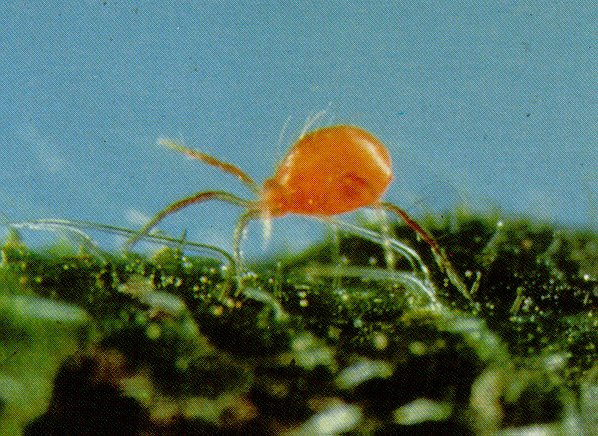
https://greenmethods.com/persimilis/
Hypoaspis Miles. Eats fungus gnats, which are the gnats that sometimes can be found around indoor plants or garbage.

https://greenmethods.com/stratiolaelaps/

https://greenmethods.com/encarsia/
Damselflies and Dragonflies. Both of these eat Mosquitoes, so are good to have around.

http://www.carolina.com/aquatic-insects/damselfly-nymphs-living-pk-12/143520.pr

http://www.carolina.com/aquatic-insects/dragonfly-nymphs-living-pk-12/143526.pr
Ladybugs eat Aphids, so they are good to have around, and you can farm them with Aphids as food. A Gallon of Ladybugs is over $70.

https://www.planetnatural.com/product/live-ladybugs/
Orius Insidiousus. Eats mites.
https://upload.wikimedia.org/wikipedia/commons/5/5b/Orius_insidiosus_from_USDA_2_(cropped).jpg
https://greenmethods.com/orius/
Assassin Bugs. These eat Cockroaches and Bedbugs.

http://www.arbico-organics.com/product/assassin-bug-zelus-renardii/beneficial-insects-predators-parasites
Soldier Bug. These eat over 100 kinds of pests.

http://www.arbico-organics.com/product/spined-soldier-bug-podisus-maculaventris/beneficial-insects-predators-parasites
Praying Mantis. They eat any other kind of bug, and will even eat each other.
http://yourshot.nationalgeographic.com/u/ss/fQYSUbVfts-T7pS2VP2wnKyN8wxywmXtY0-Fwsgxo7q7my7f2GZLNS4giTv8-jCBYWzPZjkOOIwdkCXxgrEb/
https://www.planetnatural.com/product/praying-mantis-egg-cases/
Mealybug Destroyers. These eat any kind of Mealybug or Scale Bug, like the kind that come in neighborhoods that have too many Crape Myrtle trees.

https://greenmethods.com/product/cryptolaemus-montrouzieri-adult-beetles/
Tiger Beetles. These eat Ants, Flies, Grasshoppers, Spiders, etc, and are used as food by people in Mexico.

Green Lacewings. These eat mites and aphids.

https://greenmethods.com/chrysoperla/
Ichneumon wasp. These wasps lay a parasitic eggs that eat the eggs of pest bugs like aphids. They do not sting, their stinger is used to lay eggs more precisely.

Trichogramma wasp. Another parasitic egg laying wasp.

https://www.planetnatural.com/product/trichogramma-wasps/
A. Colemani. Parasitic eggs against aphids.

https://greenmethods.com/product/aphidius-colemani-parasitoid-mummies/
Phytoseiulus Persimilis. Eats spider mites but won't bite humans or pets. Good for indoor plant growers as spider mites are an indoor problem usually.

https://greenmethods.com/persimilis/
Hypoaspis Miles. Eats fungus gnats, which are the gnats that sometimes can be found around indoor plants or garbage.

https://greenmethods.com/stratiolaelaps/
